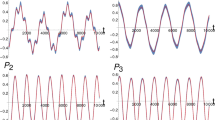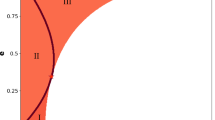Abstract
We develop a code to compute different chaos indicators for the planetary N body problem. The code uses a second order symplectic integrator to advance the Hamiltonian flow of the system in heliocentric canonical coordinates, and the corresponding variational equations. The chaos indicators are computed over a dense grid of initial conditions, allowing to map the stability of the phase space in detail. The code computes the MEGNO indicator and the time variance of the orbital elements, among others. We take advantage of the GPU parallelization with CUDA to simulate the nodes of the grid simultaneously. We apply this code to analyze the stability of the Kepler-46 system of exoplanets. This system is constituted by a Jupiter and a Saturn size planets in tightly packed orbits. The presence of a third, super-Earth size, planet has been also hypothesized. Our analysis helps to reveal the main resonant structure of the system, which shows many similarities with our own solar system. All the planets in the system lie in regions of regular motion, even considering their orbital uncertainties. Our results also put constraints to the possible radial migration of the planets in the system, indicating that the pair of Jovian planets could have never got closer than the location of the 2:3 resonance.



Similar content being viewed by others
Data availability
Data sharing not applicable to this article, as no datasets were generated or analysed during the current study.
Notes
When mutual perturbations are strong, radial velocities alone can also be used to constrain the masses.
References
C. Lovis, D. Fischer, Radial velocity techniques for exoplanets. in Exoplanets, ed. by S. Seager (2010), pp. 27–53
S. Seager, G. Mallén-Ornelas, A unique solution of planet and star parameters from an extrasolar planet transit light curve. Astrophys. J. 585, 1038–1055 (2003). https://doi.org/10.1086/346105
D.A. Fischer, G. Anglada-Escude, P. Arriagada, R.V. Baluev, J.L. Bean, F. Bouchy, L.A. Buchhave, T. Carroll, A. Chakraborty, J.R. Crepp, R.I. Dawson, S.A. Diddams, X. Dumusque, J.D. Eastman, M. Endl, P. Figueira, E.B. Ford, D. Foreman-Mackey, P. Fournier, G. Fűrész, B.S. Gaudi, P.C. Gregory, F. Grundahl, A.P. Hatzes, G. Hébrard, E. Herrero, D.W. Hogg, A.W. Howard, J.A. Johnson, P. Jorden, C.A. Jurgenson, D.W. Latham, G. Laughlin, T.J. Loredo, C. Lovis, S. Mahadevan, T.M. McCracken, F. Pepe, M. Perez, D.F. Phillips, P.P. Plavchan, L. Prato, A. Quirrenbach, A. Reiners, P. Robertson, N.C. Santos, D. Sawyer, D. Segransan, A. Sozzetti, T. Steinmetz, A. Szentgyorgyi, S. Udry, J.A. Valenti, S.X. Wang, R.A. Wittenmyer, J.T. Wright, State of the field: extreme precision radial velocities. Publ. Astron. Soc. Pac. 128(6), 066001 (2016). https://doi.org/10.1088/1538-3873/128/964/066001
A.C. Cameron, Extrasolar planetary transits. in Methods of Detecting Exoplanets: 1st Advanced School on Exoplanetary Science. Astrophysics and Space Science Library, ed. by V. Bozza, L. Mancini, A. Sozzetti, vol. 428 (2016), p. 89. https://doi.org/10.1007/978-3-319-27458-4_2
D. Charbonneau, T.M. Brown, D.W. Latham, M. Mayor, Detection of planetary transits across a sun-like star. Astrophys. J. Lett. 529, 45–48 (2000). https://doi.org/10.1086/312457
S. Ferraz-Mello, T.A. Michtchenko, C. Beaugé, The orbits of the extrasolar planets HD 82943c and b. Astrophys. J. 621, 473–481 (2005). https://doi.org/10.1086/427276
J. Miralda-Escudé, Orbital perturbations of transiting planets: a possible method to measure stellar quadrupoles and to detect earth-mass planets. Astrophys. J. 564, 1019–1023 (2002). https://doi.org/10.1086/324279
E. Agol, J. Steffen, R. Sari, W. Clarkson, On detecting terrestrial planets with timing of giant planet transits. Mon. Not. Roy. Astron. Soc. 359, 567–579 (2005). https://doi.org/10.1111/j.1365-2966.2005.08922.x
M.J. Holman, N.W. Murray, The use of transit timing to detect terrestrial-mass extrasolar planets. Science 307, 1288–1291 (2005). https://doi.org/10.1126/science.1107822
E.J. Rivera, G. Laughlin, R.P. Butler, S.S. Vogt, N. Haghighipour, S. Meschiari, The Lick–Carnegie Exoplanet Survey: a Uranus-Mass fourth planet for GJ 876 in an extrasolar Laplace configuration. Astrophys. J. 719(1), 890–899 (2010). https://doi.org/10.1088/0004-637X/719/1/890. arXiv:1006.4244 [astro-ph.EP]
D. Nesvorný, D.M. Kipping, L.A. Buchhave, G.Á. Bakos, J. Hartman, A.R. Schmitt, The detection and characterization of a nontransiting planet by transit timing variations. Science 336, 1133 (2012). https://doi.org/10.1126/science.1221141
X. Saad-Olivera, D. Nesvorný, D.M. Kipping, F. Roig, Masses of Kepler-46b, c from transit timing variations. Astron. J. 153, 198 (2017). https://doi.org/10.3847/1538-3881/aa64e0
S.L. Grimm, J.G. Stadel, The GENGA code: gravitational encounters in N-body simulations with GPU acceleration. Astrophys. J. 796, 23 (2014). https://doi.org/10.1088/0004-637X/796/1/23
S. Hellmich, S. Mottola, G. Hahn, E. Kührt, D. de Niem, Influence of the Yarkovsky force on Jupiter Trojan asteroids. Astron. Astrophys. 630, 148 (2019). https://doi.org/10.1051/0004-6361/201834715
J.E. Chambers, A hybrid symplectic integrator that permits close encounters between massive bodies. Mon. Not. Roy. Astr. Soc. 304, 793–799 (1999). https://doi.org/10.1046/j.1365-8711.1999.02379.x
H. Kinoshita, H. Yoshida, H. Nakai, Symplectic integrators and their application to dynamical astronomy. Cel. Mech. Dyn. Astr. 50(1), 59–71 (1991)
J. Wisdom, M. Holman, Symplectic maps for the n-body problem. Astron. J. 102, 1528–1538 (1991). https://doi.org/10.1086/115978
J.M.A. Danby, Fundamentals of Celestial Mechanics, 2nd edn. (Willmann-Bell, Richmond, 1988)
S. Mikkola, K. Innanen, Symplectic tangent map for planetary motions. Celest. Mech. Dyn. Astron. 74(1), 59–67 (1999). https://doi.org/10.1023/A:1008312912468
P.M. Cincotta, C. Simó, Simple tools to study global dynamics in non-axisymmetric galactic potentials—I. Astron. Astrophys. Suppl. 147, 205–228 (2000). https://doi.org/10.1051/aas:2000108
P.M. Cincotta, C.M. Giordano, C. Simó, Phase space structure of multi-dimensional systems by means of the mean exponential growth factor of nearby orbits. Physica D Nonlinear Phenom. 182(3–4), 151–178 (2003). https://doi.org/10.1016/S0167-2789(03)00103-9
R. Metzler, J.-H. Jeon, A.G. Cherstvy, E. Barkai, Anomalous diffusion models and their properties: non-stationarity, non-ergodicity, and ageing at the centenary of single particle tracking. Phys. Chem. Chem. Phys. 16, 24128–24164 (2014). https://doi.org/10.1039/C4CP03465A
N. Haghighipour, S. Capen, T.C. Hinse, Detection of Earth-mass and super-Earth Trojan planets using transit timing variation method. Celest. Mech. Dyn. Astron. 117(1), 75–89 (2013). https://doi.org/10.1007/s10569-013-9510-y
X. Saad-Olivera, A. Costa de Souza, F. Roig, D. Nesvorný, Masses of the Kepler-419 planets from transit timing variations analysis. Mon. Not. Roy. Astron. Soc. 482(4), 4965–4971 (2019). https://doi.org/10.1093/mnras/sty2990
X. Saad-Olivera, C.F. Martinez, A. Costa de Souza, F. Roig, D. Nesvorný, A super-Earth and a mini-Neptune around Kepler-59. Mon. Not. Roy. Astron. Soc. 491(4), 5238–5247 (2020). https://doi.org/10.1093/mnras/stz3369
S. Ferraz-Mello, T.A. Michtchenko, D. Nesvorný, F. Roig, A. Simula, The depletion of the Hecuba gap vs the long-lasting Hilda group. Planet. Space Sci. 46(11–12), 1425–1432 (1998). https://doi.org/10.1016/S0032-0633(98)00023-3
A. Morbidelli, M. Moons, Secular resonances in mean motion commensurabilities: the 2/1 and 3/2 cases. Icarus 102(2), 316–332 (1993). https://doi.org/10.1006/icar.1993.1052
J. Laskar, P. Robutel, Stability of the planetary three-body problem. I. Expansion of the planetary hamiltonian. Celest. Mech. Dyn. Astron. 62(3), 193–217 (1995). https://doi.org/10.1007/BF00692088
Acknowledgements
The authors acknowledge support form the Brazilian Foundation for the Improvement of High Level Personnel (CAPES) and the Brazilian Council of Research (CNPq). Simulations have been performed at the SDumont cluster of the Brazilian National System of High Performance Processing (SINAPAD), and the Netuno cluster of the Federal University of Rio de Janeiro (UFRJ).
Author information
Authors and Affiliations
Contributions
All the authors contributed equally to this work.
Corresponding author
Ethics declarations
Conflict of interest
The authors have no competing interests to declare that are relevant to the content of this article.
Appendix A
Appendix A
The Hamiltonian Eq. (1) has a drawback when dealing with a few body problem. In a system with only two bodies (\(n=1\)), it reduces to
so a two body system is not represented by its corresponding Keplerian Hamiltonian. The symplectic integrator treats the last term in Eq. (A1) as a perturbation of the Keplerian motion, and this introduces a spurious precession of the periastron of the orbit. In a many body system, this effect is negligible compared to the mutual gravitational perturbations (Eq. 3), but for a few body system it may become relevant. A possibility to overcome this consists to incorporate the pure quadratic terms of Eq. (4) into the Keplerian part Eq. (2). The Hamiltonian then takes the form:
where \(\nu _i=(m_0+m_i)/m_0\) and \(M_i=m_0/\nu _i\). The second order symplectic integrator in this case reduces to the same steps as before, except that steps 3 and 6 become
and the Keplerian solution in steps 4 and 5 must be advanced over the re-scaled time step \(h^\prime =\nu _ih\).
Alternatively, we may introduce the reduced masses \(\mu _i=m_0m_i/(m_0+m_i)\) to write the Keplerian part as [28, e.g.]:
where \({\textbf {p}}_i=\mu _i{\textbf {v}}_i^\prime \) and \({\textbf {v}}_i^\prime = \nu _i{\textbf {v}}_i\).
Rights and permissions
Springer Nature or its licensor (e.g. a society or other partner) holds exclusive rights to this article under a publishing agreement with the author(s) or other rightsholder(s); author self-archiving of the accepted manuscript version of this article is solely governed by the terms of such publishing agreement and applicable law.
About this article
Cite this article
de Souza, A.C., Roig, F. & Saad-Olivera, X. GPU accelerated stability maps for extrassolar planetary systems: the Kepler-46 system. Eur. Phys. J. Spec. Top. 232, 3119–3129 (2023). https://doi.org/10.1140/epjs/s11734-023-01037-7
Received:
Accepted:
Published:
Issue Date:
DOI: https://doi.org/10.1140/epjs/s11734-023-01037-7




